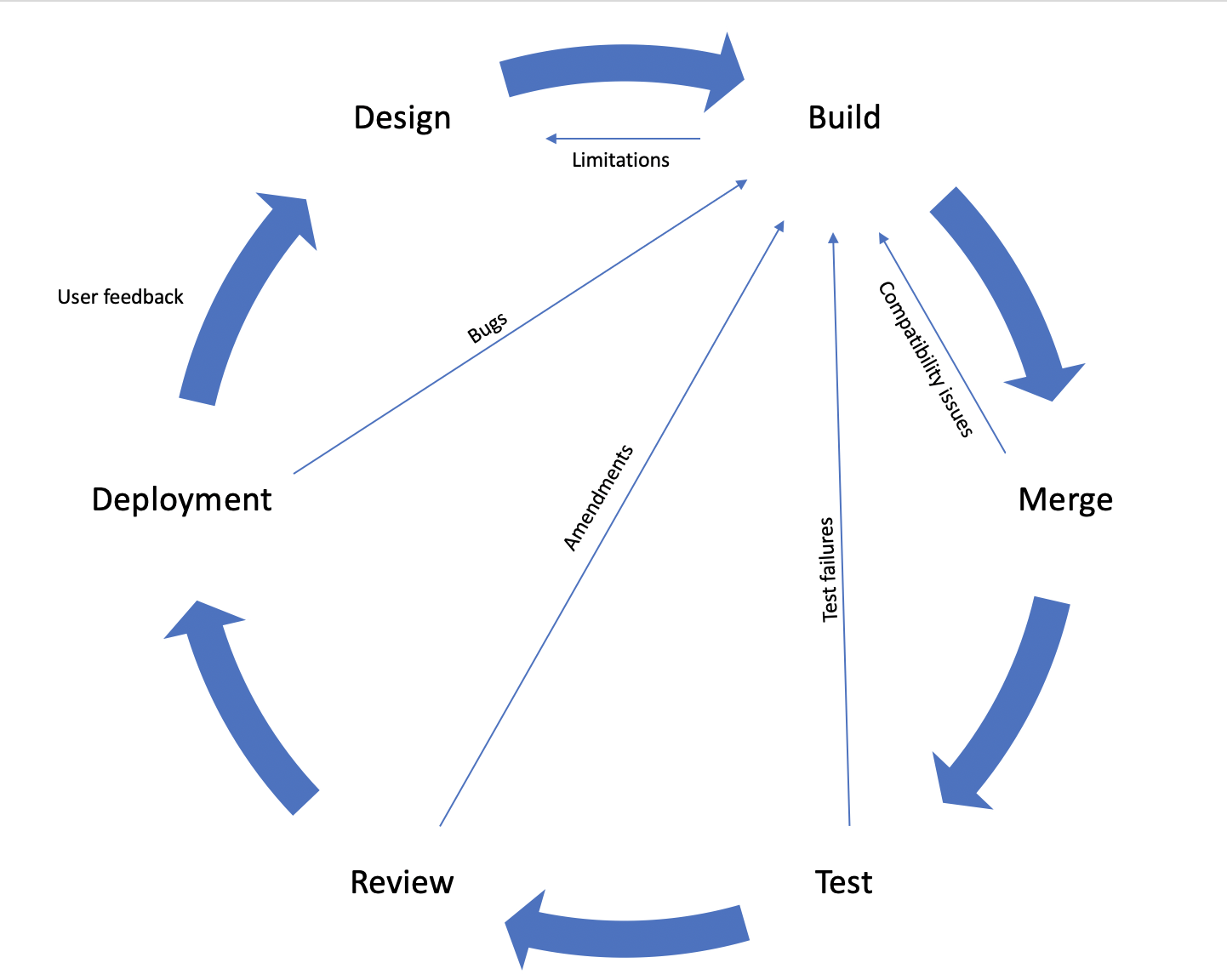How To Give Your DevOps Feedback Loop The Update It Needs
Your DevOps team should always be looking to improve the speed and quality of your process. We discuss a few solutions to enhance your feedback loops.
Join the DZone community and get the full member experience.
Join For FreeIntroduction
With the highest performing DevOps teams deploying on average four times a day, the pressure is on. Your team should always be looking to improve the speed and quality of your process. A solution may be closer than you think.
What Is a Feedback Loop?
In society, we receive feedback continuously, from friends, family, and colleagues. Companies often have office telephone systems or entire call centers dedicated to receiving feedback from their customers. So, what is it doing in your DevOps process?
Feedback is the information or data you receive on a product you have made or a task you have performed. This feedback can be used to improve the product or the process you perform to make it.
Throughout your DevOps process, there are multiple occasions you will receive feedback, even if you don’t call it by that name. These different processes create what is known as your feedback loop.
A feedback loop is created by the interactions between the different sections of your DevOps team, as well as interactions between the end-users and the product. Keeping track of this data is vital to maintaining a healthy feedback loop, so it’s worth investing in small business management software or a team collaboration solution to enable this.
For example; an architect may design a nice new framework, at which point they pass it to the developers. If the developer finds this framework doesn’t work with what they already have, then it will be sent back to the architect until the idea is perfected. This is one small cross-section of your feedback loop.
Below you can see a feedback loop in its entirety.

In your DevOps process, there should be one large feedback loop as shown above, but it should also contain many smaller loops. It would be useless to collect the end-user data on its own, and so we depend on feedback throughout the process to inform us.
With older methods of working, such as the waterfall method, the flow of work is always heading downstream. Once an issue is detected further down or at the bottom it can prove hard to rectify. Having multiple feedback loops doesn’t allow the project to rest at the end of your flow. Feedback is given at each stage to ensure the product is ready for delivery when it reaches the end and deployment.
Ultimately, your feedback loop will affect your project management, which will then, in turn, dictate the efficiency of your project. It will improve the quality of your work and the speed at which it is performed. In turn, you will be creating software that provides the best customer experience.
Here are a few suggestions on how to give your DevOps feedback loop the update it needs.
Make Use of CI and CD
Continuous Integration (CI)
CI establishes a consistent and automated way to build, package and test your applications. The goals of CI are to find and address bugs quickly, improve software quality, and reduce the time it takes to release new software.
Imagine you and a colleague have spent weeks writing large sections of code. You’re happy with the work you’ve done and now it is time to merge and piece it together. All of a sudden something doesn’t work the way it should. Now you begin the arduous search for the bugs that plague your code. CI eliminates the risk of these costly errors.

Using CI, developers commit smaller amounts of code more often to a master branch, which is automatically packaged for deployment. This process of merging and code analysis allows for bugs to be identified and acted upon before the issue gets too out of hand.
If you’re using DevOps, CI methods should already be a staple in your process. It’s worth paying attention to the ways it can improve how your building teams get feedback. If an error occurs in the CI process, then feedback is given to the builder, immediately allowing for corrections to the code.
In your DevOps process, CI and artificial intelligence should go hand in hand. AI can increase the efficiency of automated code testing, recognizing weaknesses in your build and establishing what tests will benefit your process. It can also be used to support your infrastructure, managing your storage and those mountains of data.
Continuous Delivery (CD)
CD picks up where CI left off. With most teams working within one environment, for example, testing or code building, the CD gives us an automated way of sending code changes to them. CD funnels code changes and information to the coders who decide how and when to act on them.
In essence, CD will act as the oil for your feedback loop, allowing for issues to be directed and resolved in one smooth motion.
Again, using AI is crucial in CD. AI can learn to predict where bugs are most likely to occur and which member of your team is most suited to deal with the issue. With AI to take a lead role in CD, you optimize your feedback loop, allowing your team to focus their efforts on their builds.

Cross-Functional Teams
Having classically static teams can slow you down and your weekly meeting just won’t cut it. It is time to get your best minds in the same room. Cross-functional teams are people of different disciplines working together. Uniting these individuals and having them collaborate will build a physical environment in which feedback can be given and used.
Upon the inception of the initial idea feedback and ideas can be shared immediately. This avoids going through the process of building it, only to run into issues further down the production line.
Remember, having the space to allow people to perform this work is key. You may, like many small startups or independent businesses, be short of real estate. Use tools for file sharing and asynchronous communication to allocate space and ensure this vital work goes uninterrupted.
Pair Programming
Bring together two programmers and have them work at one workstation. One should control the machine, writing code and the other should navigate, checking code or suggesting the direction for future lines of code.
Often people have been averse to this process, opting to work alone and use digital channels to share ideas but this can be an unbeatable way to work. It promotes creativity and allows feedback to be shared without those long message threads and the wait for a response.
Implementing pair programming practices can prove challenging with remote working teams but there are plenty of systems in place to help overcome these issues. For instance, the use of high-quality screen sharing software has become more common in facilitating vital co-working.
Reduce Works In Progress
Works in progress are the number of projects your team is working on at any one time. With pressure to deliver more, DevOps teams are often working on multiple projects at any given time. Of course, you should always be working towards delivering that new update or application—or at least aiming to have something concrete to show at your next online meeting. But at what cost?
Concentrate on the project at hand and identify strategies for effective team collaboration. Hopping from one project to another can be detrimental to your process. Imagine coding for one project, receiving feedback on another, and then having to fix that. This is an easy way to lose direction.
Reducing the number of projects you’re working on will do wonders for your feedback loop. It will allow your teams to provide feedback faster and enable them to respond swiftly.
User Testing
User testing is the final part of your feedback loop and arguably the most important. This feedback will be vital to the direction of your project. For instance, if you find out your users need more functionality, you can push this data back into your DevOps process. Whether it’s applications for customer management or retail ERP software, you can never be too careful about the value, the quality, you give to your customers.
User feedback is common in any project but so many choose to ignore the abundance of methods to collect this data. Gone are the days of a simple survey. Contact with your consumer needs to be more three-dimensional.
Call your customers. The human touch is second to none. Establishing what users need and resolving their issues is always easier with direct contact. This doesn’t mean calling them at all hours of the day. A preview dialer is a maximum time-saving tool that can help make smart decisions as to who, when, and why you’re calling.
Equally, it is important to engage customers on their own ground. With the focus on marketing and social media interaction growing, you can use these platforms to inform you. Gather data on what users want through methods such as social listening.
Finally, build your user feedback methods into your application. Interactive content and functionality can offer users the chance to give feedback in a less mundane fashion.
Conclusion
It is always worthwhile analyzing your feedback loop, but it is important to tailor your updates to your team and project. Implementing any one of these methods will prove beneficial, improving the way you work, as well as the speed and quality of your work.
It is, however, important to mention that whilst looking at the way you provide and use feedback will help, if you don’t look at the bigger picture then these updates could all be in vain.
Communication between team members is a key part of your feedback loop. This is vital, especially for remote working teams. Tools such as video conferencing software enable you to meet regularly, share ideas and establish just how you can work towards your project goals. Promote healthy communication and collaboration between your team before even attempting to adopt new practices.
Opinions expressed by DZone contributors are their own.

Comments